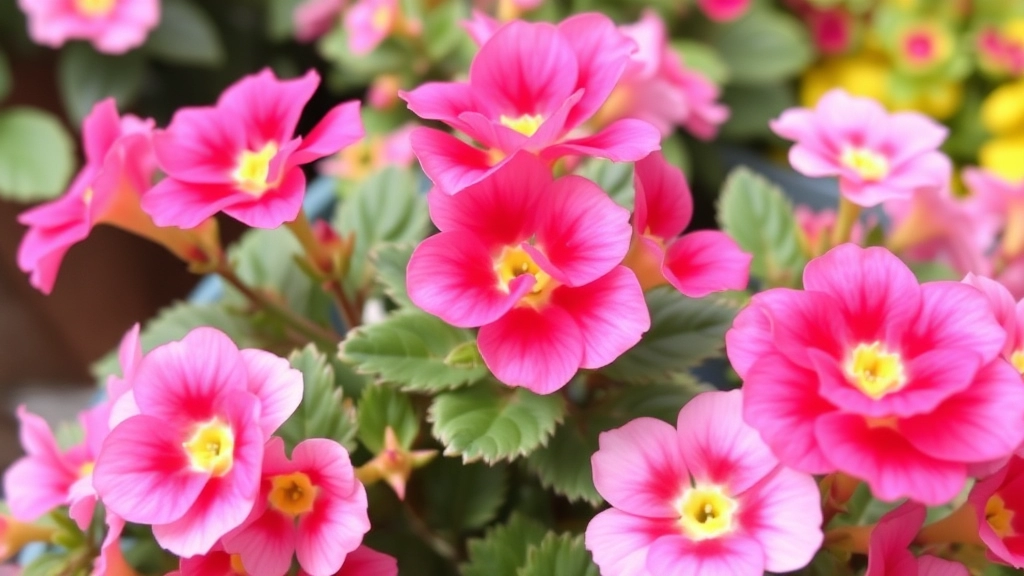Care for Your Florist Kalanchoe Pink
Looking to add a vibrant touch to your home with a Florist Kalanchoe Pink? You’re in the right place! This flowering succulent is not only eye-catching but also incredibly low-maintenance, making it perfect for both novice and experienced plant lovers. Let’s dive into the best ways to care for your Pink Kalanchoe, ensuring it thrives indoors and adds a splash of colour to your space.
Creating the Ideal Environment
First things first, creating the ideal environment is key. Your Pink Kalanchoe will flourish in well-draining soil and a pot that allows for proper airflow. Watering should be minimal; let the soil dry out completely between waterings to avoid root rot. And don’t forget about light! This plant loves bright, indirect sunlight, so placing it near a window is a great idea.
Tips for a Healthy Kalanchoe
With these tips, your Florist Kalanchoe Pink will stay healthy and vibrant, ready to brighten up any room.
Best Conditions for Growing Pink Kalanchoe Indoors
Are you struggling to keep your Pink Kalanchoe thriving indoors? You’re not alone. Many plant enthusiasts face challenges in creating the ideal environment for these beautiful succulents.
Watering and Soil Requirements for Healthy Kalanchoe Growth
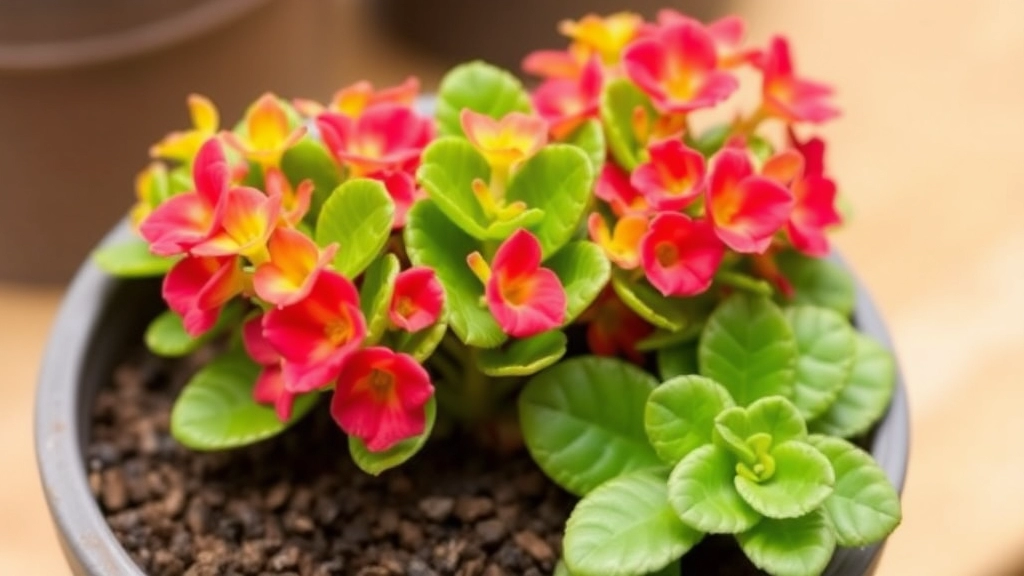
So, you’ve got your lovely pink Kalanchoe, and now you’re wondering how to keep it thriving, right?
Watering Your Kalanchoe
Watering can be a bit tricky. Too much, and you risk root rot; too little, and your plant will suffer. Here’s a simple guide:
- Check the Soil: Stick your finger about an inch into the soil. If it feels dry, it’s time to water.
- Watering Frequency: Generally, every 2-3 weeks is ideal, but this can change with the seasons.
- Watering Technique: Water thoroughly until it drains from the bottom. This ensures all roots get a drink.
Soil Requirements
Now, let’s talk soil. Kalanchoe loves a well-draining mix. Here’s what to look for:
- Cactus Mix: A pre-made cactus or succulent mix is a solid choice.
- DIY Mix: You can also create your own by mixing regular potting soil with sand or perlite (50/50 ratio).
- Potting Considerations: Make sure your pot has drainage holes. This helps prevent water from sitting at the bottom.
Signs of Over or Under-Watering
It’s essential to keep an eye on your plant. Here are some signs to watch for:
- Over-Watering: Yellowing leaves, mushy stems, or a foul smell from the soil.
- Under-Watering: Wrinkled leaves or a droopy appearance.
Light Preferences: How Much Sunlight Does Your Kalanchoe Need?
When it comes to nurturing your pink Kalanchoe, understanding its light requirements is essential. Many plant owners often wonder: How much sunlight does my Kalanchoe really need? The answer can significantly impact the health and vibrancy of your plant.
Kalanchoe thrives best in bright, indirect sunlight. Here’s a quick guide to ensure your plant gets the right amount of light:
- Optimal Light Conditions: Place your Kalanchoe near a south or west-facing window where it can receive bright light for a few hours each day.
- Avoid Direct Sunlight: While Kalanchoe enjoys sunlight, too much direct exposure can scorch its leaves.
- Signs of Insufficient Light: If your plant becomes leggy or the leaves start to drop, it may not be receiving enough light.
- Supplementing Light: If natural light is limited, consider using grow lights to provide the necessary brightness.
To keep your pink Kalanchoe flourishing, observe its growth and adjust its position as needed. For more detailed care tips, you can refer to our care guide for Kalanchoe with pink flowers. Additionally, if you’re interested in other vibrant varieties, check out our complete guide to Kalanchoe Blossfeldiana colors.
Tips for Choosing the Right Pot and Soil Mix for Kalanchoe

When selecting the perfect pot and soil mix for your pink Kalanchoe, you might find yourself wondering if you’re making the right choices. This is crucial for ensuring your plant thrives indoors.
Choosing the Right Pot
- Drainage is Key: Look for pots with drainage holes. Kalanchoe doesn’t like sitting in water, which can lead to root rot.
- Size Matters: A pot that’s about 2-4 inches larger in diameter than the plant’s root ball is ideal. This allows for growth without overwhelming the roots.
- Material Considerations: Terracotta pots are great for Kalanchoe as they allow moisture to evaporate. However, plastic pots can retain moisture longer, so choose based on your watering habits.
Selecting the Right Soil Mix
- Well-Draining Soil: A cactus or succulent mix is perfect. It provides the drainage Kalanchoe craves.
- DIY Soil Mix: If you prefer to make your own, combine:
- 1 part potting soil
- 1 part perlite or coarse sand
- 1 part orchid bark
- pH Level: Aim for a slightly acidic to neutral pH (around 6.0 to 7.0) for optimal growth.
As you nurture your Pink Kalanchoe, you may encounter some unwelcome guests. Understanding common pests and how to safeguard your plant is essential for its health and vibrancy.
### Common Pests to Watch For
– **Mealybugs**
– Small, white, cotton-like insects.
– Often found in leaf axils and on stems.
– **Spider Mites**
– Tiny, spider-like creatures that create fine webs.
– Leaves may appear speckled or discoloured.
– **Aphids**
– Small, green or black insects that cluster on new growth.
– Can cause leaf curling and stunted growth.
– **Scale Insects**
– Hard, shell-like bumps on stems and leaves.
– Can lead to yellowing leaves and overall decline.
### Protective Measures
– **Regular Inspection**
– Check your Kalanchoe weekly for signs of pests.
– Early detection is key to effective management.
– **Natural Remedies**
– **Neem Oil**: A natural pesticide that disrupts insect life cycles.
– **Insecticidal Soap**: Effective against soft-bodied insects like aphids and mealybugs.
– **Physical Removal**
– Use a soft cloth or cotton swab dipped in alcohol to wipe off mealybugs.
– Spray spider mites with a strong jet of water to dislodge them.
– **Encourage Beneficial Insects**
– Ladybugs and lacewings can help control pest populations naturally.
### Prevention Tips
– **Maintain Proper Care**
– Healthy plants are less susceptible to pests.
– Ensure your Kalanchoe has the right light, water, and nutrients. For more detailed care tips, check out this [care guide for flowering Kalanchoe](https://planthq.org/care-guide-for-flowering-kalanchoe-2030cm-tall-blossfeldiana/).
– **Avoid Overcrowding**
– Provide adequate air circulation around plants to deter pests.
– **Quarantine New Plants**
– Keep new additions separate for a few weeks to check for pests before introducing them to your collection. For more on identifying pests and other issues, see our [Kalanchoe succulent identification guide](https://planthq.org/kalanchoe-succulent-identification-guide-top-varieties-traits/).
Seasonal Care: Preparing Kalanchoe for Blooming and Dormancy
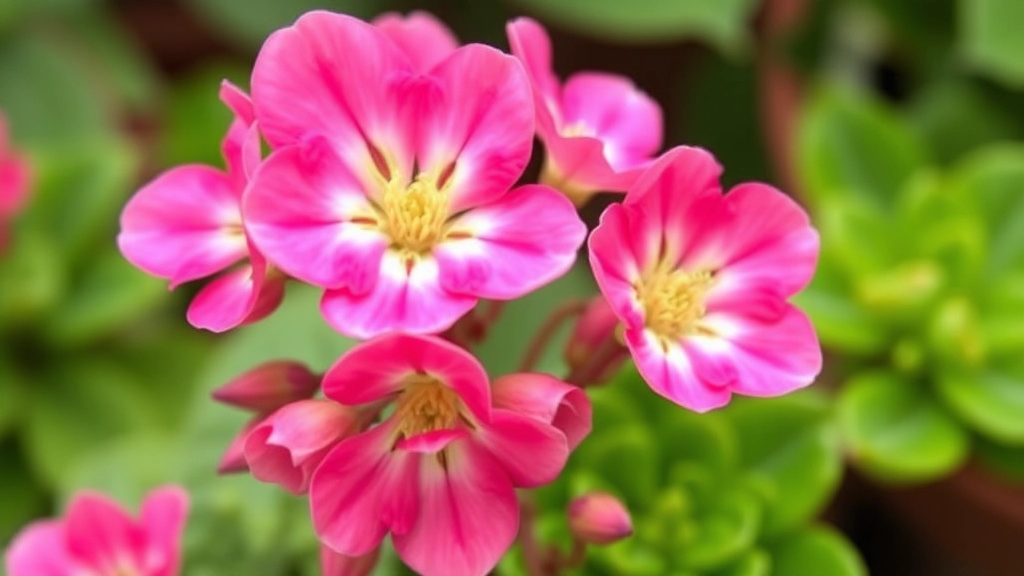
Are you wondering how to keep your pink Kalanchoe thriving through the seasons?
Getting the seasonal care right is key to ensuring your Kalanchoe not only blooms beautifully but also rests well during dormancy.
Preparing for Blooming
When it’s time for your Kalanchoe to bloom, here’s what you should do:
- Light Exposure: Ensure your plant gets plenty of bright, indirect sunlight. This helps stimulate those gorgeous flowers.
- Watering Routine: Gradually increase your watering as the blooming season approaches. Keep the soil slightly moist but never soggy.
- Fertilizing: Use a balanced, water-soluble fertiliser every couple of weeks during the blooming phase. This gives your plant the nutrients it craves.
- Temperature Check: Aim for temperatures between 18-24°C (65-75°F). This is the sweet spot for blooming.
Preparing for Dormancy
Once the blooms start to fade, your Kalanchoe will need some downtime. Here’s how to help it rest:
- Reduce Watering: Cut back on watering. Let the soil dry out between waterings to prevent root rot.
- Lower Light: Move your plant to a slightly shadier spot. It doesn’t need as much light during this period.
- Temperature Adjustment: Keep it in a cooler environment, around 15-18°C (59-65°F). This helps signal to the plant that it’s time to rest.
- No Fertiliser: Hold off on fertilising until you see new growth in spring.
Are you looking to expand your collection of pink Kalanchoe or share them with friends? Propagation is a rewarding process that allows you to create new plants from your existing ones.
There are two main methods for propagating Kalanchoe: **cuttings** and **offsets**. Both methods are straightforward and can lead to successful new plants when done correctly.
### 1. Propagating from Cuttings
– **Choose a Healthy Stem**: Select a healthy stem from your Kalanchoe. It should be firm and free of any pests or diseases.
– **Make the Cut**: Use sterilised scissors to take a cutting about 10-15 cm long. Ensure it has at least two or three leaves.
– **Let it Callus**: Place the cutting in a dry, warm area for a few days. This allows the cut end to callus over, reducing the risk of rot.
– **Planting**: Once callused, place the cutting in a well-draining soil mix. You can use a cactus or succulent mix.
– **Water Sparingly**: Water lightly after planting and then only when the soil dries out.
For more detailed information on propagation, you can refer to the [step-by-step guide for propagating Kalanchoe Tomentosa](https://planthq.org/how-to-propagate-kalanchoe-tomentosa-stepbystep-guide/).
### 2. Propagating from Offsets
– **Identify Offsets**: Offsets are small plants that grow at the base of the main plant. Look for healthy offsets that have roots.
– **Remove Carefully**: Gently twist or cut the offset away from the main plant, ensuring you don’t damage the roots.
– **Prepare the Soil**: Use a well-draining soil mix similar to that used for cuttings.
– **Planting**: Place the offset in the soil, ensuring the roots are covered.
– **Watering**: Water lightly and allow the soil to dry out between waterings.
To ensure successful propagation, you might also want to check out the [complete guide to Kalanchoe Mother of Thousands care and propagation](https://planthq.org/complete-guide-to-kalanchoe-mother-of-thousands-care-propagation/).
### Tips for Successful Propagation
– **Humidity**: Keep the cuttings in a humid environment, such as a plastic bag or a mini greenhouse, to encourage root growth.
– **Light**: Provide bright, indirect light. Direct sunlight can scorch the cuttings.
– **Patience**: It may take a few weeks for roots to develop. Be patient and keep an eye on moisture levels.
How to Encourage Pink Kalanchoe to Rebloom
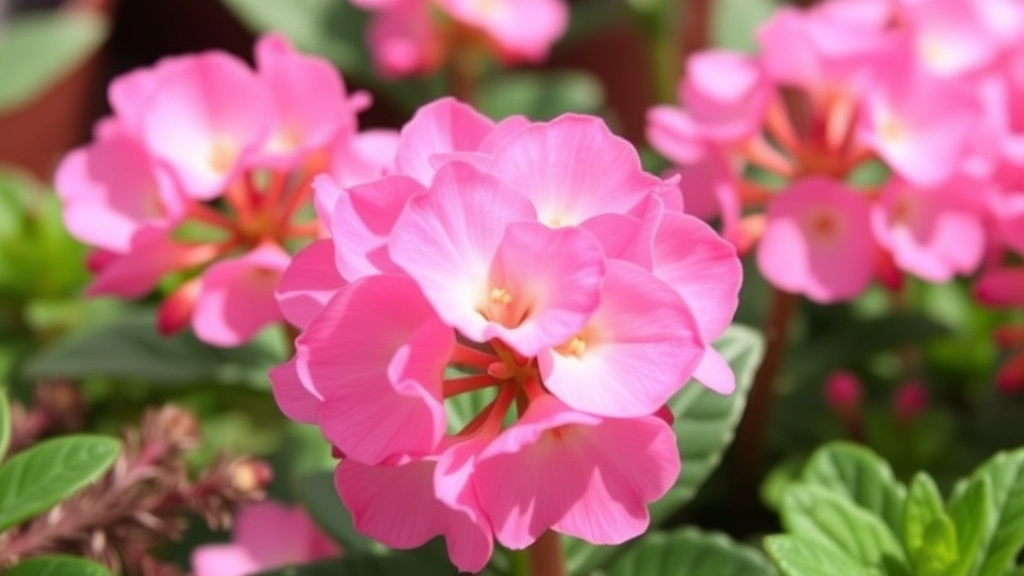
Have you ever found yourself wondering why your beautiful pink Kalanchoe isn’t blooming again? You’re not alone! Many plant lovers face this dilemma after their Kalanchoe finishes its first stunning display of flowers.
But don’t worry; getting your Kalanchoe to bloom again is totally achievable with a few simple steps.
1. Light is Key
- Bright, Indirect Sunlight: Ensure your Kalanchoe is getting plenty of bright, indirect sunlight. Too little light can hinder blooming.
- Rotate the Plant: Every so often, rotate your plant to ensure all sides get equal light exposure.
2. Watering Wisely
- Let it Dry Out: Water your Kalanchoe thoroughly, then let the soil dry out before the next watering. This helps mimic its natural environment and encourages blooming.
- Avoid Overwatering: Keep an eye out for signs of overwatering, like yellow leaves. This can stop your plant from flowering.
3. Feeding for Blooms
- Use a Balanced Fertilizer: Feed your Kalanchoe with a balanced, water-soluble fertiliser every two weeks during the growing season. This will provide the nutrients it needs to produce those gorgeous flowers.
- Switch to a Bloom Booster: When your Kalanchoe is ready to bloom, consider switching to a bloom booster fertiliser to encourage more flowers.
4. Pruning for Growth
- Trim After Blooming: Once your Kalanchoe has finished flowering, prune back the spent blooms and any leggy growth. This encourages new growth and can lead to more flowers.
- Pinch Off New Growth: Occasionally pinching off new growth can redirect energy back into blooming.
5. Create a Dormancy Period
- Resting Phase: Give your Kalanchoe a resting phase after blooming. Reduce watering and stop fertilising for about six weeks. This helps the plant gather strength for its next blooming cycle.
6. Temperature Matters
- Ideal Range: Keep your Kalanchoe in a temperature range of 15-25°C (59-77°F). Sudden temperature changes can stress the plant and inhibit blooming.
When caring for your pink Kalanchoe, you might wonder, “What temperature and humidity does my plant need to thrive?”
### Temperature Requirements
– **Optimal Range:** Kalanchoe thrives best in temperatures between **20°C to 25°C** (68°F to 77°F).
– **Nighttime Coolness:** A slight drop to around **15°C** (59°F) at night can promote healthy growth.
– **Avoid Extremes:** Keep your plant away from temperatures below **10°C** (50°F) as it can cause stress and damage.
### Humidity Preferences
– **Moderate Humidity:** Kalanchoe enjoys a humidity level of around **40% to 60%**.
– **Avoid High Humidity:** Too much moisture can lead to root rot and other issues.
– **Dry Conditions:** If your home is particularly dry, consider using a pebble tray or a humidifier to maintain adequate moisture levels.
### Tips for Maintaining Ideal Conditions
– **Location Matters:** Place your Kalanchoe in a room that stays within the ideal temperature range.
– **Monitor Changes:** Be aware of seasonal shifts that might affect temperature and humidity.
– **Use Thermometers and Hygrometers:** These tools can help you keep track of the conditions around your plant.
For more detailed guidance on how to care for your Kalanchoe, check out our [complete guide to growing Kalanchoe Mother of Thousands](https://planthq.org/complete-guide-to-growing-kalanchoe-mother-of-thousands/) and learn about the [health benefits of Kalanchoe Pinnata extract](https://planthq.org/health-benefits-of-kalanchoe-pinnata-extract/).
Using Pink Kalanchoe in Floral Arrangements and Home Décor
Have you ever wondered how to make your space pop with a splash of colour? Pink Kalanchoe is the perfect answer!
These vibrant plants aren’t just great for your indoor garden; they can also elevate your home décor and floral arrangements.
Why Choose Pink Kalanchoe?
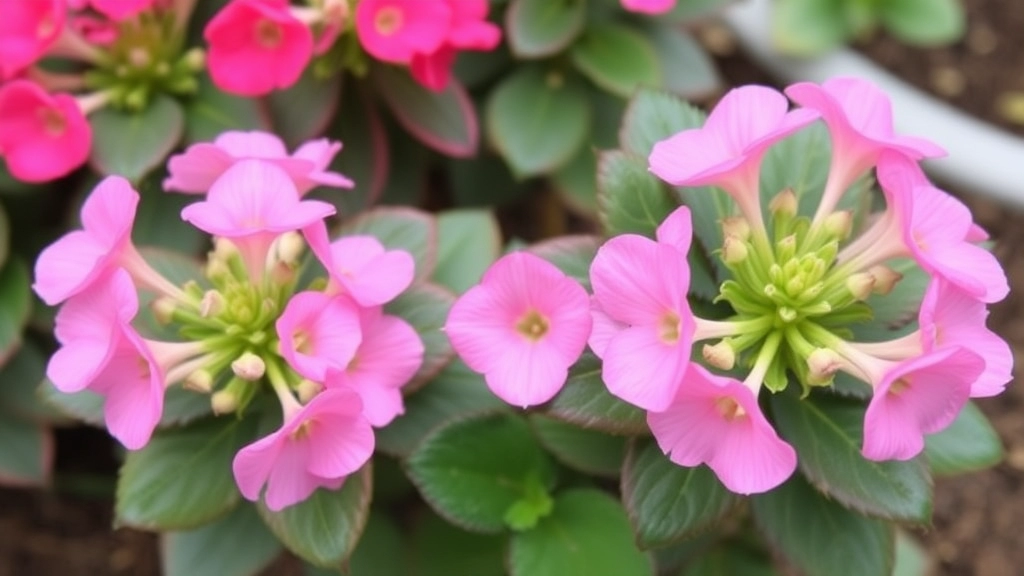
- Vibrant Colours: Their cheerful pink blooms can brighten up any room.
- Long-Lasting: These beauties can last for weeks, making them a smart choice for arrangements.
- Low Maintenance: Unlike some flowers, Kalanchoe doesn’t need constant attention.
Tips for Floral Arrangements
- Mix with Greens: Pair Kalanchoe with lush greens like ferns or eucalyptus for a fresh look.
- Choose the Right Vase: A simple glass or ceramic vase lets the flowers shine.
- Layer Heights: Use taller plants or flowers in the back and Kalanchoe in the front for a balanced arrangement.
Styling in Home Décor
- Table Centrepieces: Place a pot of Kalanchoe in the centre of your dining table for an eye-catching focal point.
- Window Sills: They thrive in sunlight, making them perfect for bright windows.
- Shelves and Nooks: Add some personality to your shelves by clustering Kalanchoe with other décor items.
Personal Touches
I love adding personal touches to my Kalanchoe displays.
Consider using decorative pots that reflect your style.
You can even paint plain pots to match your interior theme!
Common Problems and How to Troubleshoot Kalanchoe Health Issues
As we delve deeper into caring for your Pink Kalanchoe, it’s essential to address the common problems that can arise and how to troubleshoot them effectively.
1. Overwatering
One of the most frequent issues with Kalanchoe is overwatering.
- Signs: Yellowing leaves, mushy stems, and a foul smell from the soil.
- Solution: Allow the soil to dry out completely before watering again. Ensure your pot has drainage holes to prevent water from pooling.
2. Underwatering
Conversely, underwatering can also lead to health issues.
- Signs: Wrinkled leaves and a drooping appearance.
- Solution: Water your plant thoroughly and maintain a consistent watering schedule.
3. Insufficient Light
Kalanchoe thrives in bright, indirect sunlight.
- Signs: Stretching stems and pale leaves.
- Solution: Move your plant closer to a light source, ensuring it receives at least 6 hours of indirect sunlight daily.
4. Pest Infestations
Common pests like aphids and mealybugs can invade your Kalanchoe.
- Signs: Sticky residue on leaves or visible bugs.
- Solution: Treat with insecticidal soap or neem oil. Regularly inspect your plant to catch infestations early.
5. Leaf Drop
If your Kalanchoe is dropping leaves, it could be a sign of stress.
- Causes: Sudden temperature changes, overwatering, or insufficient light.
- Solution: Assess your plant’s environment and make necessary adjustments.
6. Root Rot
Root rot is a severe condition often caused by overwatering and poor drainage.
Purchasing and Caring for Kalanchoe: What to Look for When Buying
So, you’re ready to bring a Pink Kalanchoe into your home? Great choice! These vibrant plants can really brighten up your space. But before you dive in, let’s chat about what to look for when purchasing one.
What to Check When Buying Kalanchoe
- Healthy Leaves
Look for firm, vibrant leaves. Avoid any plants with yellowing or wilting leaves. They should be plump and full of life! - Strong Stems
The stems should be thick and sturdy. If they’re flimsy or drooping, it could be a sign of poor health. - No Pests
Give the plant a good once-over. Check for any signs of pests like mealybugs or spider mites. You don’t want to bring unwanted guests home! - Bloom Status
If you’re after those stunning pink flowers, check how many blooms are open. A plant with a few flowers and plenty of buds is a great sign! - Soil Condition
The soil should be dry but not bone-dry. If it’s soggy, it could indicate overwatering, which can lead to root rot.
Where to Buy
- Local Garden Centres
You can often find healthy plants here, plus you can ask staff for tips! - Online Retailers
If you’re shopping online, read reviews and check the return policy. You want a reliable seller. For great deals, you can also explore options to buy Kalanchoe Mother of Thousands online.
Caring for Your New Kalanchoe
Once you’ve picked the perfect plant, it’s time to think about care. Here are some quick tips:
- Placement: Find a bright spot in your home, but avoid direct sunlight.
- Watering: Let the soil dry out between waterings. Kalanchoe prefers to be on the drier side. For more detailed advice, check out our guide on Kalanchoe Tomentosa watering best practices.
- Humidity: They’re not fussy about humidity, but a bit of airflow helps.
FAQs About Pink Kalanchoe Care and Usage
How often should I water my pink Kalanchoe?
Generally, watering every 2-3 weeks is ideal. However, always check the soil first by sticking your finger about an inch into it. If it feels dry, it’s time to water.
What type of soil is best for Kalanchoe?
A well-draining soil mix is crucial. You can use a pre-made cactus or succulent mix or create your own by mixing regular potting soil with sand or perlite in a 50/50 ratio.
What are the signs of over-watering and under-watering?
Over-watering signs include yellowing leaves, mushy stems, or a foul smell from the soil. Under-watering signs include wrinkled leaves or a droopy appearance.
What kind of pot should I use for my Kalanchoe?
Choose a pot with drainage holes to prevent root rot. Terracotta pots are excellent as they allow moisture to evaporate, but plastic pots can retain moisture longer, so choose based on your watering habits.
How can I prepare my Kalanchoe for blooming?
Ensure your plant gets plenty of bright, indirect sunlight. Gradually increase watering as the blooming season approaches and use a balanced, water-soluble fertilizer every couple of weeks during the blooming phase.
How do I care for my Kalanchoe during its dormancy period?
Reduce watering and let the soil dry out between waterings. Move the plant to a slightly shadier spot and keep it in a cooler environment (around 15-18°C or 59-65°F). Avoid fertilizing during this period.
How can I encourage my pink Kalanchoe to rebloom?
Ensure it gets plenty of bright, indirect sunlight and water thoroughly but let the soil dry out before the next watering. Use a balanced fertilizer during the growing season and consider switching to a bloom booster when it’s ready to bloom. Prune after blooming and create a dormancy period by reducing watering and stopping fertilizing for about six weeks.
Can I use pink Kalanchoe in floral arrangements and home décor?
Absolutely! Pink Kalanchoe’s vibrant blooms can brighten up any room and are long-lasting. They can be used in floral arrangements mixed with greens or as table centerpieces, on window sills, and on shelves or nooks to add a splash of color to your home décor.
What are some tips for creating floral arrangements with Kalanchoe?
Pair Kalanchoe with lush greens like ferns or eucalyptus for a fresh look. Choose simple glass or ceramic vases to let the flowers shine and layer heights by placing taller plants in the back and Kalanchoe in the front for a balanced arrangement.
How can I add a personal touch to my Kalanchoe displays?
Consider using decorative pots that reflect your style or even paint plain pots to match your interior theme. Adding personal touches can make your Kalanchoe displays even more unique and appealing.
References
-
Gardening Know How – Kalanchoe Plant Care
-
The Spruce – Growing Kalanchoe Indoors
-
The Old Farmer’s Almanac – Kalanchoe
